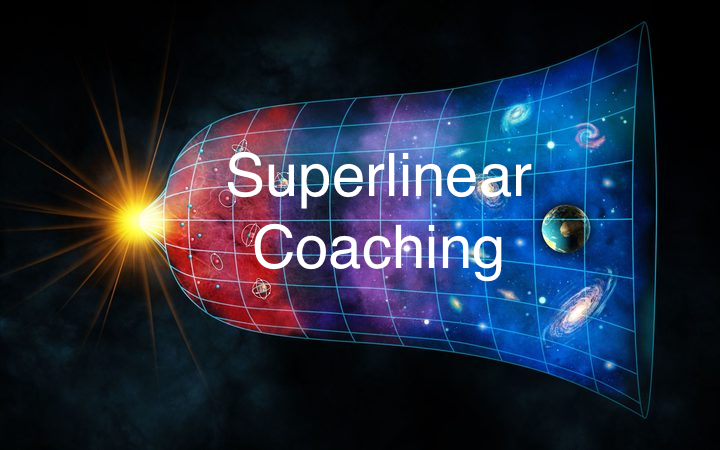Superlinear Coaching
The super highway between the real and imagined worlds
In Sapiens, Yuval Harari says we live in a world of dual reality. The objective world of rivers, trees and lions and the imaginary world of gods, nations and organisations. Into this imaginary world I would add the infinite avalanche of leadership mumbo jumbo that has been unleashed upon poor homo sapiens since the days of In Search Of Excellence.
Clearly, however, we are all still searching. In many ways coaching is an attempt to find a bridge between the real world of products and services and the imaginary world of a bi-pedal mammal.
For this challenge we have customised Superlinear Coaching.
First, some clarity. I am discussing a coaching method to drive measurable business performance in the world of objective realty. I am specifically excluding journeys to find the 'inner self' (whatever that means) which may lead individuals to leave the city, buy some camels and live in the desert.
Second, some important background and assumptions for Superlinear Coaching.
- Every organisation is a complex and dynamic system that can gain or lose energy over time.
- We define this energy as the practical ability to think and act intelligently. The higher the energy the greater the chance of survival and growth.
- Every organisation is on a half-life curve of ten years, responding to a sub-linear scale driven by economies of scale. (Organisational death is inevitable, survival is the exception.)
- To survive the grim reaper, grow and be profitable, leaders and their organisations need to customise and implement superlinear strategies and actions.
- Let's keep this simple. Entropy is the natural and inevitable loss of energy over time. Superlinearity on the other hand is the deliberately structured injection of energy designed to combat the destructive force of entropy. This is the goal of superlinear coaching.
- New thinking seldom drives new sustainable behaviour. (This is largely an unproven imagined reality found in the corridors of academia.) New behaviour drives new behaviour.
The goal of superlinear coaching therefore is to assist individuals to adopt new behaviours and actions that stimulate higher levels of intelligent thinking and intelligent action over time.
Here are some of the key steps we take with superlinear coaching. I hope you find them useful or at least stimulate some constructive debate.
Each person lives and dies within a distinct cone of possibility. In the picture above think of the light point as the present moment with the cone to the right representing the space and time continuum that you have access to in your lifetime. Now imagine your current life's pathway through the centre of the cone. This is your default imagined reality pathway, evolved from a combination of inherited genes and life's experiences. Let's call this Path A. This drives how you think and act, often in a relatively autonomous fashion. Others will experience this as your personality.
Assume now you wish to alter your default pathway to one of greater energy. Let's call this Path B.
This is the first step in superlinear coaching. We don't focus on the past, nor do we focus on a discrete or isolated issue or event. We focus instead on a new imagined reality pathway through both time and space.
We use a combination of our own customised 360 report (self, manager, colleagues) with facilitated interviews. Behaviour is always complex and variable. We place particular emphasis on temperament and consistency of behaviour and what the individual's default behaviour patterns are under pressure. (Once a dog bites you, you are unlikely to ever trust it again, for example.)
If you don't use a good 360 tool at least interview the coachee, the manager and the colleagues. Look for dominant patterns of repeated behaviour and discuss with the coachee. Then develop the new Path B with the coachee.
To confirm. Our imagined realty is that new thinking is an unreliable driver of new behaviour under pressure. Implemented new actions are a more reliable indicator of new behaviour. In addition there is plenty of evidence that new actions repeated on a regular basis generate new neuronal pathways and - a possibility - that this process even fires up different genes. Effectively each repeated simple action is like a hologram, where the future becomes path dependent on the present.
A common problem amongst many managers is poor listening skills - perhaps they interrupt, show impatience, create stress, act as if people are stupid, and exhibit annoying narcissistic traits - all combining to destroy team trust and cohesion.
A simple new superlinear action for the coachee is the following. "Wait until the person you are talking to finishes speaking. Do not interrupt under any circumstances. Then count to three and ask a question."
Try this in your own life if you are a manager or team leader, or if you are a coach, try this with a coachee. As long as the simple action is repeated on a daily basis superlinearity is the natural consequence. Observe what evolves. And if you are happy with what emerges in the real world, start customising your own superlinear bridges.
And have fun with the process!
Comments
By accepting you will be accessing a service provided by a third-party external to https://quanta.consulting/

